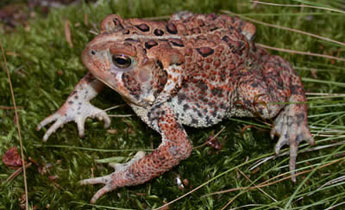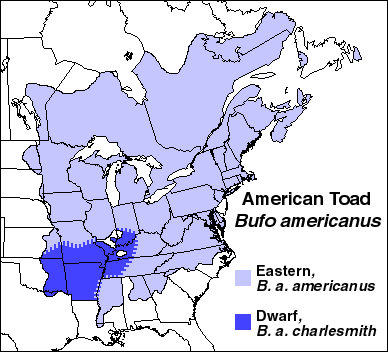American toad: Difference between revisions
No edit summary |
No edit summary |
||
| Line 16: | Line 16: | ||
|- | |- | ||
! scope="col" | Classification | ! scope="col" | Classification | ||
Animalia | | Animalia | ||
Chordata | | Chordata | ||
Amphibia | | Amphibia | ||
Anura | | Anura | ||
Bufonidae | | Bufonidae | ||
Anaxyrus | | Anaxyrus | ||
|} | |} | ||
Revision as of 14:17, 10 March 2023
American toad(Anaxyrus americanus)
Taxonomy
| Kingdom | Phylum | Class | Order | Family | Genus | |
|---|---|---|---|---|---|---|
| Classification | Animalia | Chordata | Amphibia | Anura | Bufonidae | Anaxyrus |
Description
The American toad is a common toad species that can be found throughout the Eastern and Central parts of the United States and Canada. This species is a medium size toad that grows up to 5-9 cm or 2-4 inches in length with females generally being slightly larger than males. Its coloration can change depending on the temperature, humidity, and stress levels of their environment. American toads are predominantly brown and can display hues of red or olive green. Their bellies are whitish or yellow, usually with dark spots. They have noticeable warts on their skin, including two large ones behind their eyes. The warts behind their eyes are their parotoid glands which are major salivary glands found in animals. These parotoid glands secrete a bufotoxin that is used to deter predators. Bufotoxin is a milky toxin made up of steroid lactones and is only harmful if ingested but can cause illness in animals.
Range and Subspecies
These toads can be found throughout most of the Eastern and Central parts of the United States and Canada. It prefers cool woodlands with lots of moisture, but can live in meadows, fields, and gardens. There are thought to be three different subspecies of the American Toad. There are currently two subspecies of the American toad, the Eastern American toad (Anaxyrus americanus) and the Dwarf American toad (A. a. charlesmithi). The range of the Dwarf American toad is more concentrated.There has been some hybridization with the Woodhouse's toad (Anaxyrus woodhousii) when there is range overlap, which is native to the Central United States.
Life Cycle and Behavior
Depending on temperature and location, mating can being as early as March and ends in July. The males will find a shallow spot in wetlands or ponds and call to attract females. The males generally only call at night but will call during wet days during the peak of mating season. [1] Once the mating takes place the female will lay from 2,000- 20,000 eggs in a long strand. The eggs will hatch after 3-12 days. The eggs hatching usually happens from June to August. Once the eggs hatch they develop into tadpoles and then after about 60 days turn into fully developed toads. While tadpoles are developing they feed on algae. An American Toad will reach sexual maturity after 2-4 years. Once the toads reach adulthood they feed during the early morning into the night. The toads feed on a variety of insects. The toad will often hide in leaf litter to avoid predators. The toads will burrow in moist soils, and hibernate in these burrows during the winter.
References
Altig, Ronald, et al. Handbook of Larval Amphibians of the United States and Canada. 1st ed., Cornell University Press, 2015. JSTOR, www.jstor.org/stable/10.7591/j.ctt1tm7g59. Accessed 12 Apr. 2021.
(“Eastern American Toad Fact Sheet - Signs of the Seasons: A New England Phenology Program - University of Maine Cooperative Extension”) “IUCN Red List of Threatened Species.” IUCN Red List of Threatened Species, https://www.iucnredlist.org/species/54570/56843565. Accessed 12 Apr. 2021.
Pauly, Gregory B., et al. “THE HISTORY OF A NEARCTIC COLONIZATION: MOLECULAR PHYLOGENETICS AND BIOGEOGRAPHY OF THE NEARCTIC TOADS (BUFO).” Evolution, no. 11, The Society for the Study of Evolution, 2004, p. 2517. Crossref, doi:10.1554/04-208.
Vaughan, Andres, and Joseph R. Mendelson. “Taxonomy and Ecology of the Central American Toads of the Genus Crepidophryne (Anura: Bufonidae).” Copeia, no. 2, American Society of Ichthyologists and Herpetologists (ASIH), May 2007, pp. 304–14. Crossref, doi:10.1643/0045-8511(2007)7[304:taeotc]2.0.co;2.
“IUCN Red List of Threatened Species.” IUCN Red List of Threatened Species, https://www.iucnredlist.org/species/54570/56843565. Accessed 12 Apr. 2021.

